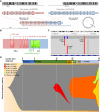Lorlatinib and compound mutations in ALK+ large-cell neuroendocrine lung carcinoma: a case report
- PMID: 36207130
- PMCID: PMC9632356
- DOI: 10.1101/mcs.a006234
Lorlatinib and compound mutations in ALK+ large-cell neuroendocrine lung carcinoma: a case report
Abstract
Large-cell neuroendocrine lung carcinoma (LCNEC) is a high-grade neoplasm with median survival of 1 year and limited therapeutic options. Here, we report the unusual case of a 47-yr-old female smoker with stage IV LCNEC featuring EML4-ALK variant 2 (E20:A20), wild-type TP53/RB1, and low tumor mutational burden of 3.91 mut/Mb. Despite early progression within 3 mo under crizotinib, a durable response was achieved with alectinib. Oligoprogression in the left breast 10 mo later was treated by surgery, followed by a switch to ceritinib upon multifocal progression and detection of ALK:p.V1180L in the mastectomy specimen, but without success. Another rebiopsy revealed ALK:p.L1196M, but the tumor did not respond to brigatinib or carboplatin/pemetrexed, before stabilization under lorlatinib. Diffuse progression 8 mo later with detection of ALK :p.L1196M/p.G1202R and p.L1196M/ p.D1203N evolving from the previous p.L1196M did not respond to chemoimmunotherapy, and the patient succumbed with an overall survival (OS) of 37 mo. This case illustrates the importance of molecular profiling for LCNEC regardless of smoking status, and the superiority of next-generation ALK inhibitors compared to crizotinib for ALK+ cases. Lorlatinib retained efficacy in the heavily pretreated setting, whereas its upfront use could possibly have prevented the stepwise emergence of compound ALK mutations. Furthermore, the disease course was more aggressive and OS shorter compared to the V2/TP53wt ALK+ lung adenocarcinoma, whereas crizotinib, ceritinib, and brigatinib did not confer the benefit expected according to next-generation sequencing results, which also underline the need for more potent drugs against ALK in the high-risk setting of neuroendocrine histology.
Keywords: lung adenocarcinoma.
© 2022 Wiedemann et al.; Published by Cold Spring Harbor Laboratory Press.
Figures



Similar articles
-
Resistance profiles of anaplastic lymphoma kinase tyrosine kinase inhibitors in advanced non-small-cell lung cancer: a multicenter study using targeted next-generation sequencing.Eur J Cancer. 2021 Oct;156:1-11. doi: 10.1016/j.ejca.2021.06.043. Epub 2021 Aug 13. Eur J Cancer. 2021. PMID: 34392186
-
Drug resistance mechanisms in Japanese anaplastic lymphoma kinase-positive non-small cell lung cancer and the clinical responses based on the resistant mechanisms.Cancer Sci. 2020 Mar;111(3):932-939. doi: 10.1111/cas.14314. Epub 2020 Feb 8. Cancer Sci. 2020. PMID: 31961053 Free PMC article.
-
Efficacy of Lorlatinib in Treatment-Naive Patients With ALK-Positive Advanced NSCLC in Relation to EML4::ALK Variant Type and ALK With or Without TP53 Mutations.J Thorac Oncol. 2023 Nov;18(11):1581-1593. doi: 10.1016/j.jtho.2023.07.023. Epub 2023 Aug 3. J Thorac Oncol. 2023. PMID: 37541389
-
Brigatinib and lorlatinib: their effect on ALK inhibitors in NSCLC focusing on resistant mutations and central nervous system metastases.Jpn J Clin Oncol. 2021 Jan 1;51(1):37-44. doi: 10.1093/jjco/hyaa192. Jpn J Clin Oncol. 2021. PMID: 33147606 Review.
-
Transformation of NSCLC to SCLC harboring EML4-ALK fusion with V1180L mutation after alectinib resistance and response to lorlatinib: A case report and literature review.Lung Cancer. 2023 Dec;186:107415. doi: 10.1016/j.lungcan.2023.107415. Epub 2023 Oct 28. Lung Cancer. 2023. PMID: 37907052 Review.
Cited by
-
Transformation of ALK-positive NSCLC to SCLC after alectinib resistance and response to combined atezolizumab: a case report.Transl Lung Cancer Res. 2023 Mar 31;12(3):637-646. doi: 10.21037/tlcr-23-154. Epub 2023 Mar 28. Transl Lung Cancer Res. 2023. PMID: 37057117 Free PMC article.
-
Case report: Therapeutic response to lorlatinib in advanced large-cell neuroendocrine carcinoma of the lung and breast cancer: a heterochronous double malignancy perspective.Front Pharmacol. 2024 Dec 10;15:1413897. doi: 10.3389/fphar.2024.1413897. eCollection 2024. Front Pharmacol. 2024. PMID: 39723252 Free PMC article.
-
An advanced NSCLC patient with ALK-RNF144A and HIP1-ALK fusions treated with ALK-TKI combination therapy: a case report.Transl Lung Cancer Res. 2023 Dec 26;12(12):2538-2549. doi: 10.21037/tlcr-23-656. Epub 2023 Nov 24. Transl Lung Cancer Res. 2023. PMID: 38205210 Free PMC article.
-
Two case reports: EML4-ALK rearrangement large cell neuroendocrine carcinoma and literature review.Front Oncol. 2023 Nov 1;13:1227980. doi: 10.3389/fonc.2023.1227980. eCollection 2023. Front Oncol. 2023. PMID: 38023218 Free PMC article.
-
Misdiagnosis of bilateral breast metastases as primary benign tumors secondary to lung large-cell neuroendocrine carcinoma: a case report.Discov Oncol. 2025 Jun 14;16(1):1101. doi: 10.1007/s12672-025-02855-y. Discov Oncol. 2025. PMID: 40515859 Free PMC article.
References
-
- Angeles AK, Christopoulos P, Yuan Z, Bauer S, Janke F, Ogrodnik SJ, Reck M, Schlesner M, Meister M, Schneider MA, et al. 2021. Early identification of disease progression in ALK-rearranged lung cancer using circulating tumor DNA analysis. NPJ Precis Oncol 5: 100. 10.1038/s41698-021-00239-3 - DOI - PMC - PubMed
-
- Camidge DR, Kim HR, Ahn MJ, Yang JCH, Han JY, Hochmair MJ, Lee KH, Delmonte A, Campelo MRG, Kim DW, et al. 2021. Brigatinib versus crizotinib in ALK inhibitor-naive advanced ALK-positive NSCLC: final results of phase 3 ALTA-1L trial. J Thor Dis 16: 2091–2108. 10.1016/j.jtho.2021.07.035 - DOI - PubMed
Publication types
MeSH terms
Substances
LinkOut - more resources
Full Text Sources
Medical
Research Materials
Miscellaneous
